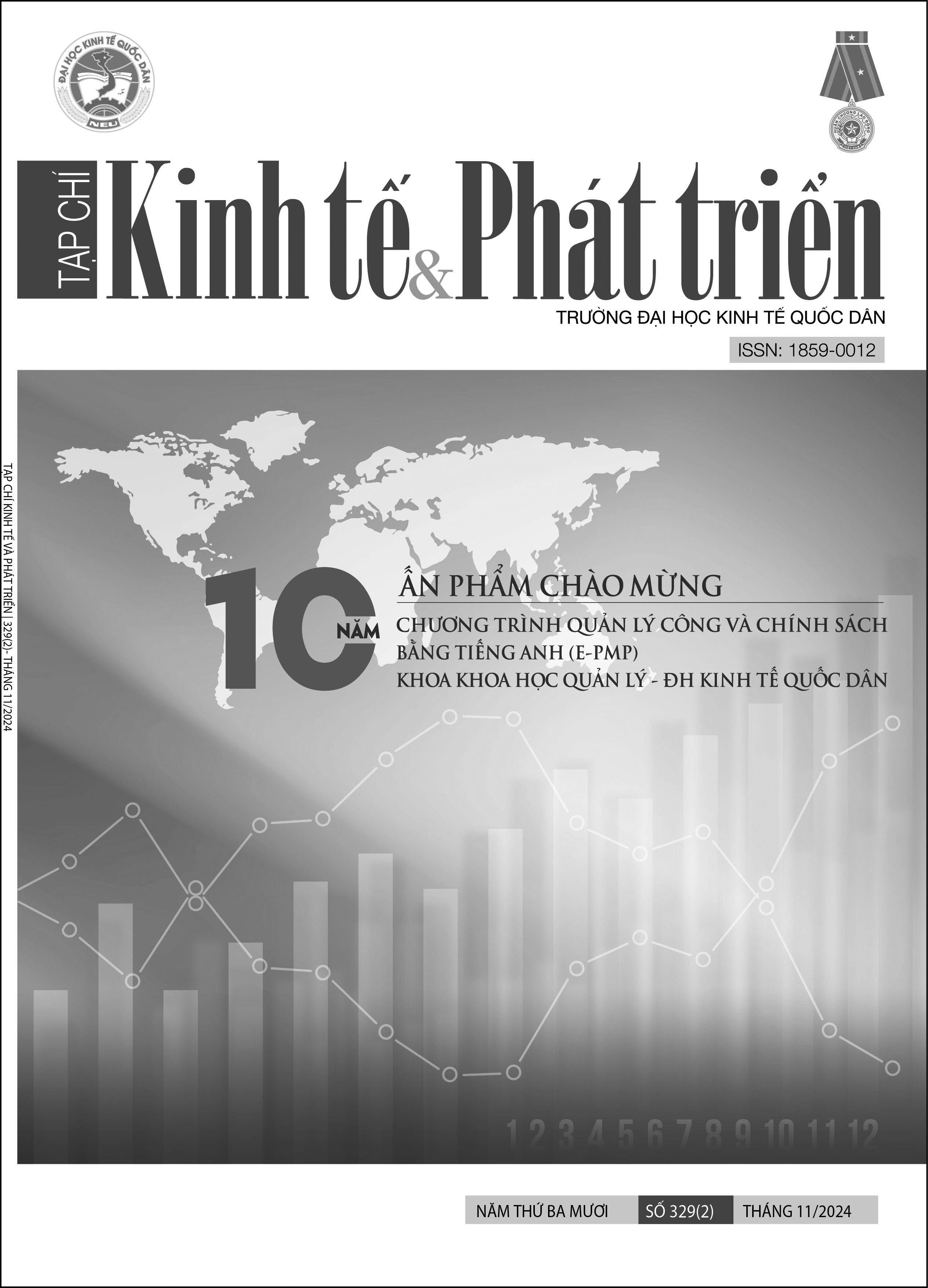Bất đối xứng thông tin trong thị trường nhà ở và chính sách nhà ở công nhân khu công nghiệp trong bối cảnh chuyển đổi số
DOI:
https://doi.org/10.33301/JED.VI.1955Từ khóa:
Chuyển đổi số, nhà ở công nhân, chính sách nhà ở, bất đối xứng thông tinTóm tắt
Công nhân có nhu cầu nhà ở vẫn đối diện nhiều thách thức có nguyên nhân từ những vấn đề cố hữu của thị trường nhà ở hay còn gọi là những thất bại của thị trường như bất đối xứng thông tin thị trường nhà ở. Mục tiêu của nghiên cứu là làm rõ hơn lý thuyết về những yếu tố tác động đến sự bất đối xứng thông tin nhà ở gây gia tăng chi phí cho bên cầu nhà ở. Xây dựng mô hình, chứng minh và kiểm định các giả thuyết về bất đối xứng thông tin, hiệu quả phương thức tìm kiếm thông tin thông qua giai đoạn tìm kiếm trước, các yếu tố tác động đến giai đoạn tìm kiếm trước thông tin sử dụng dữ liệu về nhà ở của công nhân khu công nghiệp. Nghiên cứu chứng minh tác động và hiệu quả của giai đoạn tìm kiếm trước thông tin đối với hiệu quả quá trình tìm kiếm làm giảm bất đối xứng thông tin, kiểm định các tác nhân ảnh hưởng đến giai đoạn tìm kiếm trước thông tin. Cuối cùng, nghiên cứu đề xuất một số hàm ý chính sách trong bối cảnh chuyển đổi số hướng tới giảm thiểu tác động của bất đối xứng thông tin nhà ở.
Tài liệu tham khảo
Akerlof, G.A. (1970), ‘The market for “lemons”: Quality uncertainty and the market mechanism’, The Quarterly Journal of Economics, 488-500. https://doi.org/10.4337/9781781950005
Arnott, R. (1987), ‘Economic theory and housing’, Handbook of regional and urban economics, 2, 959-988.
Boeing, G. (2020), ‘Online rental housing market representation and the digital reproduction of urban inequality’, Environment and Planning A: Economy and Space, 52(2), 449-468.
Carrillo, P.E. (2008), Information and real estate transactions: the effects of pictures and virtual tours on home sales, Department of Economics, The George Washington University, Washington, DC.
Cherif, E. & Grant, D. (2014), ‘Analysis of e-business models in real estate’, Electronic Commerce Research, 14, 25-50. doi:10.1007/s10660-013-9126-z.
De Leeuw, F. (1971), ‘The demand for housing: A review of cross-section evidence’, The Review of Economics Statistic, 1-10.
Eerola, E. & Lyytikäinen, T. (2015), ‘On the role of public price information in housing markets’, Regional Science and Urban Economics, 53, 74-84.
Ford, J.S., Rutherford, R.C. & Yavas, A. (2005), ‘The effects of the internet on marketing residential real estate’, Journal of Housing Economics, 14(2), 92-108.
Gurran, N. & Bramley, G. (2017), Urban planning and the housing market, Palgrave Macmillan UK, doi: 10.1057/978-1-137-46403-3
Han, L. & Strange, W.C. (2015), ‘The microstructure of housing markets: Search, bargaining, and brokerage’, Handbook of regional and urban economics, 5, 813-886.
Ihlanfeldt, K. & Mayock, T. (2012), ‘Information, search, and house prices: Revisited’, Journal of Real Estate Finance and Economics, 44, 90-115.
JICA (2016), The study for improvement of living conditions for workers around industrial areas in Socialist Republic of Vietnam: Final report, from <https://openjicareport.jica.go.jp/pdf/12263364_01.pdf ngày 28-04-2024>.
Korver-Glenn, E., Lee, H. & Crowder, K. (2024), ‘Real Estate platforms, the housing search process and racial residential stratification’, Race and Social Problems, 16(1), 133-156.
Krysan, M. and Crowder, K. (2017), Cycle of segregation: Social Processes and Residential Stratification, New York: Russell Sage Foundation.
Lambson, V.E., McQueen, G.R. & Slade, B.A. (2004), ‘Do out‐of‐state buyers pay more for real estate? An examination of anchoring‐induced bias and search costs’, Real Estate Economics, 32(1), 85-126.
LHI (2021), Báo cáo Dự án xây dựng chính sách toàn diện phát triển nhà ở xã hội Việt Nam, Hàn Quốc.
Li, L. & Chau, K.W. (2024), ‘Information Asymmetry with Heterogeneous Buyers and Sellers in the Housing Market’, The Journal of Real Estate Finance and Economics, 68(1), 138-159.
Ling, D.C., Naranjo, A. & Petrova, M.T. (2018), ‘Search Costs, Behavioral Biases, and Information Intermediary Effects’, The Journal of Real Estate Finance and Economics, 1-38.
Liu, Y., Gallimore, P. & Wiley, J.A. (2015), ‘Nonlocal office investors: anchored by their markets and impaired by their distance’, The Journal of Real Estate Finance and Economics, 50(1), 129-149.
Malpezzi, S. & Mayo, S.K. (1997), ‘Getting housing incentives right: a case study of the effects of regulation, taxes, and subsidies on housing supply in Malaysia’, Land Economics, 372-391.
Mayo, S.K. (1981), ‘Theory and estimation in the economics of housing demand’, Journal of Urban Economics, 10, 95-116.
McCarthy, K. (2021), ‘An analytical model of housing search and mobility’, In Modelling housing market search, Routledge, 30-53.
Megbolugbe, I., Marks, A. & Schwartz, M. (1991), ‘The Economic Theory of Housing Demand: A Critical Review’, Journal of Real Estate Research, 6(3), 381-393.
Rashidi, T.H., Auld, J. & Mohammadian, A.K. (2012), ‘A behavioral housing search model: Two-stage hazard-based and multinomial logit approach to choice-set formation and location selection’, Transportation Research Part A: Policy and Practice, 46(7), 1097-1107.
Tổng cục Thống kê (2023), Báo cáo Điều tra lao động việc làm năm 2022, Hà Nội.
Turnbull, G.K. & Sirmans, C.F. (1993), ‘Information, search, and house prices’, Regional Science and Urban Economics, 23(4), 545-557.
Weimer, D. & Vining, A. (2017), Policy Analysis: Concepts and Practice, Taylor & Francis.
Zhou, X., Gibler, K. & Zahirovic-Herbert, V. (2015), ‘Asymmetric buyer information influence on price in a homogeneous housing market’, Urban Studies, 52(5), 891-905.





